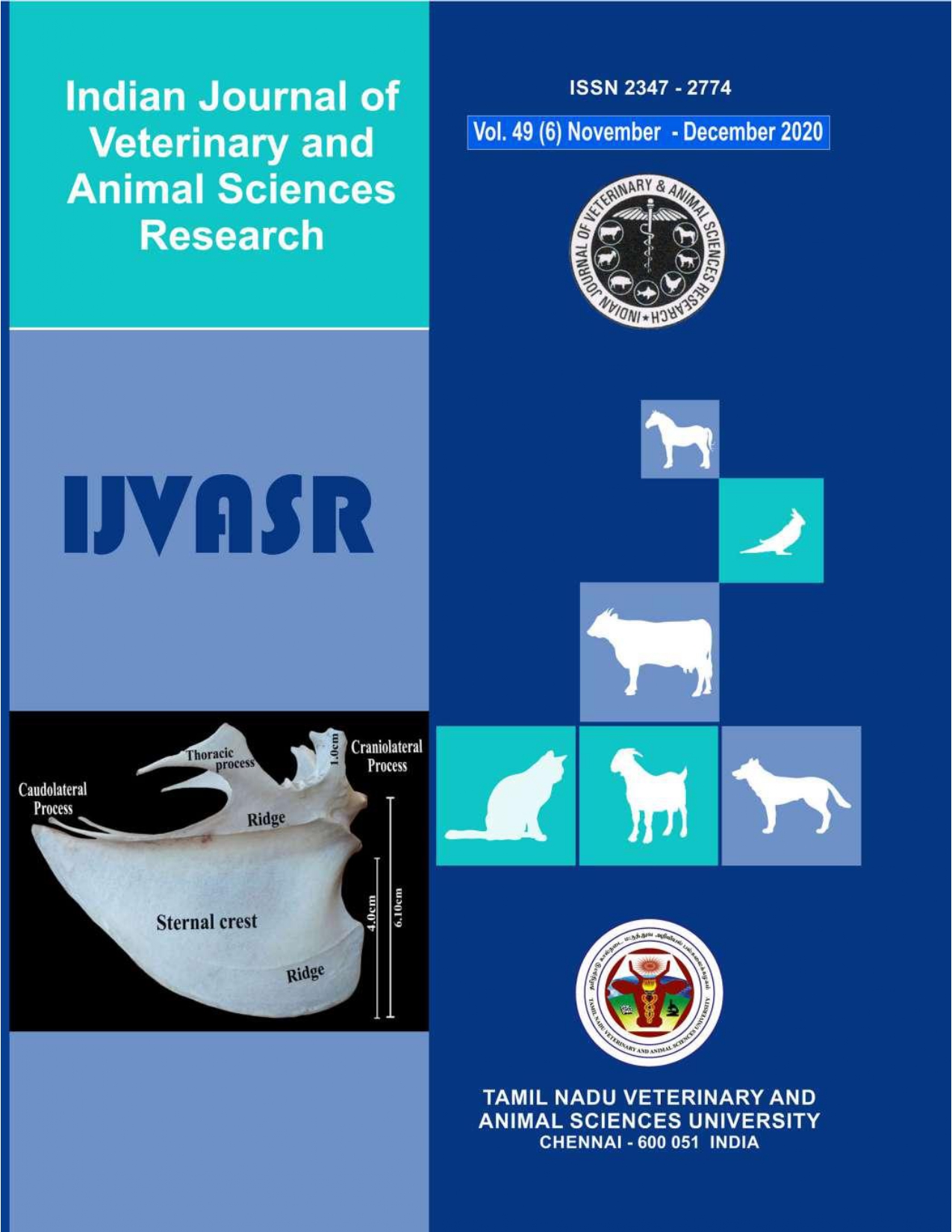PREVALENCE AND MOLECULAR CHARACTERIZATION OF MAJOR Culicoides SPECIES FOUND IN SELECTED PARTS OF TAMIL NADU
Keywords:
Culicoides species, Prevalence, DNA barcoding, COI gene, Sheep farmAbstract
Culicoides are the biting midges that are involved in the transmission of bluetongue, an economically important disease of small ruminants particularly sheep. The prevalence of Culicoides species in and around sheep farms of selected districts of Tamil Nadu was investigated by setting up UV- LED CDC traps. A total of 1787 specimens of Culicoides were collected, out of which Culicoides imicola was found to be in abundance. The other species included Culicoides oxystoma, Culicoides peregrinus, Culicoides brevitarsis and Culicoides fulvus. It was found that female midges outnumbered the male population in all the identified species. The overall percentage distribution of pigmented, non-pigmented, blood fed and gravid forms were observed to be 25.73%, 25.49%, 38.95% and 9.81% respectively. Morphological identification was complemented by molecular characterization using barcodes obtained by amplification of the mitochondrial eytochrome oxidase gene. The results of BLAST analysis revealed that all the other four species grouped with their respective species clusters except C. oxystoma which showed a higher degree of genetic divergence.
Downloads
References
Ander, M., Troell, K. and Chirico, J. (2013). Barcoding of biting midges in the genus Culicoides: a tool for species determination. Medical and Veterinary Entomology, 27: 323-331.
Archana, M., Souza, P.E.D., Prasad, R.C. and Byregowda, S.M. (2014). Seasonal prevalence of different Culicoides species in Bangalore rural and urban districts of South India. Veterinary World, 7: 517 - 521.
Bakhoum, M. T., Fall, M., Fall, A.G., Bellis, G.A., Gottlieb, Y., Labuschagne, K., Venter, G.J., Diop, M., Mall, I. and Seck, M.T. (2013). First record of Culicoides oxystomaand diversity of species within the Schultzei Group of Culicoides latreille (Diptera: Ceratopogonidae) biting midges in Senegal. PLOSOne, 8: e84316.
Bellis, G., Dyce, A., Gopurenko, D., Yanase, T., Garros, C., Labuschagne, K. and Mitchell, A. (2014). Revision of the Culicoides imicolacomplex (Diptera: Ceratopogonidae) from the Australasian region. Zootaxa, 3768: 401 - 427.
Bhoyar, R., Udupa, K.G., Thimmareddy, P.M., Kasralikar, V.R. and Madhav Prasad, C.B. (2009). Climatological factors associated with abundance of culicoides midges. Journal of Veterinary Parasitology, 26:148.
Dadawala, A., Biswas, S., Rehman, W., Chand, K.A., Kumar, P., Chauhan, H., Chandel, B. and Mondal, B. (2012). Isolation of bluetongue virus serotype1 from culicoides vector captured in livestock farms and sequence analysis of the viral genome segment Transboundary and Emerging Diseases, 59: 361 - 368.
Harrup, L.E., Laban, S., Purse, P.V., Reddy, Y.K., Byregowda, Y.N., Kumar, S.M., Purushotham, N., Kowalli, K.M., Prasad, V., Bettis, G., Keyser, A.A. De., Logan, R., Garros, J., Gopurenko, C., Bellis, D., Labuschagne, G., Mathieu, K. and Carpenter, B. (2016). DNA barcoding and surveillance sampling strategies for culicoides biting midges (Diptera: Ceratopogonidae) in Southern India. Parasites and Vectors, 9: 461 - 481.
IBVNET (2020). Website of IBVNet project Grant no. BB/H009167/1 under the Combating Infectious Diseases of Livestock for International Development (CIDLID) program jointly funded by BBSRC, DFID, and the Scottish government. http://www. ibvnet.com Accessed 27 March, 2020.
Ilango, K. (2006). Bluetongue virus outbreak in Tamil Nadu, southern India: Need to study the Indian biting midge vectors, Culicoides latreille (Diptera: Ceratopogonidae). Current Science, 90(2): 163 - 167.
Krishnamohan Reddy, Y., Brindha, K., Ganesan, P.I., Srinivas, K., Reddy, G.S. and Minakshi, P. (2016). Occurrence of bluetongue in ruminants in Tamil Nadu, South India. Veterinaria Italiana, 52: 279 - 283.
Losson, B., Mignon, B. and Paternostre, J. (2007). Biting midges overwintering in Belgium. Veterinary Record, 160: 451 - 452.
Mellor, P.S., Boorman, J. and Baylis, M. (2000). Culicoides biting midges: their role as arbovirus vectors. Annual Review of Entomology, 45: 307 - 340.
Meyer, A. (2008). DNA sequences in taxonomy - opportunities and challenges. In: Wheeler Q.D.- (ed). The New taxonomy. The Systematic Association Special Volume Series. CRC Press, Boca Raton (Florida), - pp: 95-127.
Mullens, B.A., Tabachnick, W.J., Holbrook, F.R. and Thompson, L.H. (1995). Effects of temperature on virogenesis of bluetongue virus serotype 11 in Culicoides variipennissonorensis. Medical and Veterinary Entomology, 9: 71 - 76.
Onyango, M.G., Michuki, G. N., Ogugo, M., Venter, G.J., Miranda, M.A., Elissa, N., Djikeng, A., Kemp, S., Walker, P.J. and Duchemin, J.B. (2015). Delineation of the population genetic structure of Culicoides imicola in East and South Africa. Parasitology and Vectors, 8 (1): 660 - 667.
Purse, B.V., Carpenter, S., Venter, G. J., Bellis, G. and Mullens, B.A. (2014). Bionomics of temperate and tropical Culicoides midges: knowledge gaps and consequences for transmission of Culicoides borne viruses. Annual Review of Entomology, 60: 373 - 393.
Satheesha, S. P., Udupa, K., Labuschagne, G. and Prasanna Kumar, V. (2006). Temporal abundance of Culicoides species near the sheds of domestic animals and their possible implication on transmission of Bluetongue. National seminar on strategies for control of bluetongue, Andhra Pradesh.
Snedecor, G.W. and Cochran, W.G. (1984). Statistical methods (8thEdn.), lowa State University Press, USA.
Udupa, K.G. (2001). Culicoides species (Diptera: Ceratopogonidae) associated with livestock and the relevance to bluetongue infection in Tamil Nadu. Ph.D Thesis, Tamil Nadu Veterinary and Animal Sciences University, Chennai.
Wirth, W.W. and Hubert, A.A. (1989). The Culicoides of Southeast Asia (Diptera: Ceratopogonidae). In: The American Entomological Institute: Gainesville, Florida. pp: 508.
Zhang, Z., Schwartz, S., Wagner, L. and Miller, W. (2000). A greedy algorithm for aligning DNA sequences. Journal of Computational Biology, 7: 203 -214.
Downloads
Submitted
Published
Issue
Section
License
All the copy right belongs to the sponsoring Organization, Tamil Nadu Veterinary and Animal Sciences University, Chennai - 51.

